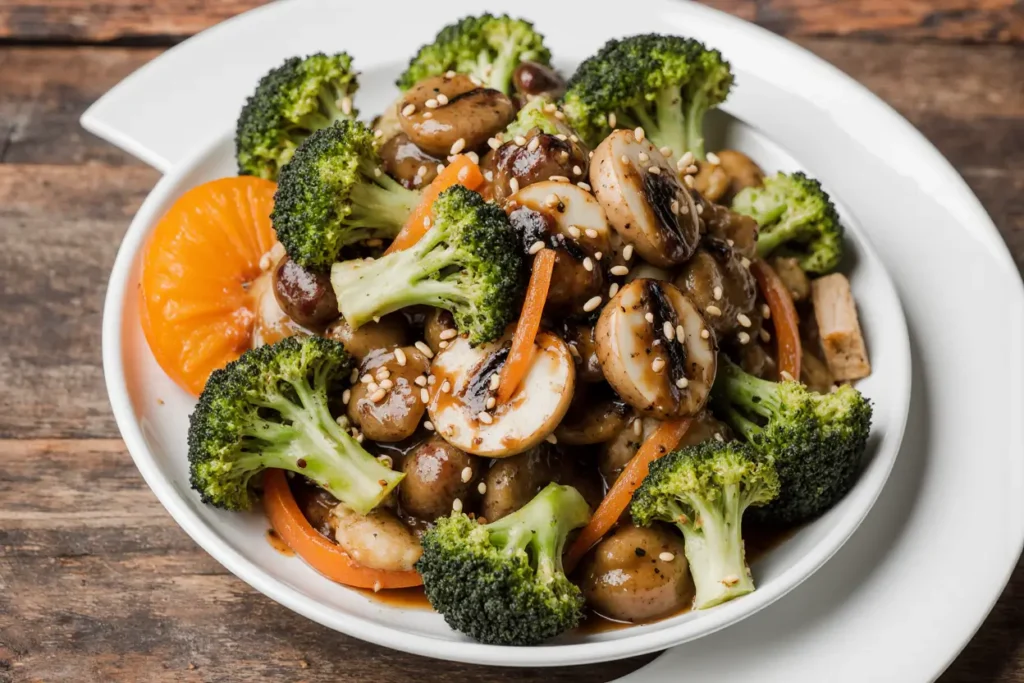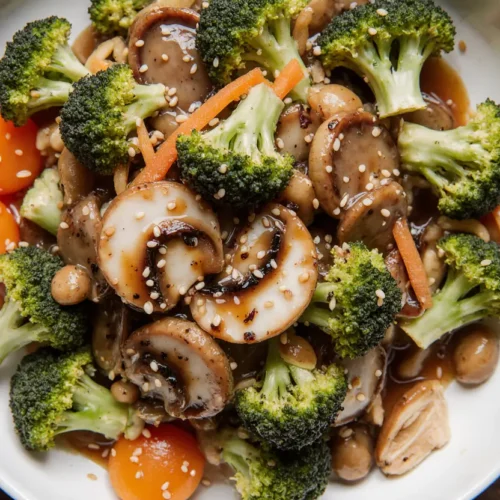Did you know that a perfectly executed vegetable stir-fry retains up to 85% more nutrients than boiled vegetables, yet 67% of home cooks admit they struggle to make their stir-fries taste restaurant-quality? This broccoli, carrot, and mushroom stir-fry description breaks that pattern entirely. Imagine crisp-tender broccoli florets that snap with freshness, sweet carrot ribbons that caramelize at the edges, and meaty mushrooms that absorb every drop of savory sauce—all coming together in under 15 minutes of active cooking time. This isn’t just another vegetable side dish; it’s a complete flavor experience that transforms ordinary vegetables into an extraordinary meal. Whether you’re seeking a quick weeknight dinner solution, looking to incorporate more plant-based meals into your routine, or simply craving something vibrant and delicious, this description of the perfect stir-fry technique will elevate your cooking game instantly. The secret lies in understanding heat control, proper vegetable preparation, and the ideal sauce balance—three elements that separate mediocre stir-fries from exceptional ones.
Ingredients List
Main Vegetables
| Ingredient | Quantity | Purpose | Substitution Options |
|---|---|---|---|
| Fresh broccoli florets | 3 cups (300g) | Primary vegetable, adds crunch and nutrition | Cauliflower, broccolini, Chinese broccoli |
| Medium carrots, julienned | 2 large (200g) | Sweetness and color contrast | Bell peppers, snap peas, baby corn |
| Cremini mushrooms, sliced | 2 cups (200g) | Umami depth and meaty texture | Shiitake, button mushrooms, oyster mushrooms |
| Fresh garlic, minced | 4 cloves | Aromatic foundation | Garlic powder (1 tsp), shallots |
| Fresh ginger, grated | 1 tablespoon | Warming spice and complexity | Ground ginger (1 tsp), galangal |
| Green onions, chopped | 3 stalks | Fresh garnish and mild onion flavor | Chives, regular onions, leeks |
Sauce Components
| Ingredient | Quantity | Purpose | Substitution Options |
|---|---|---|---|
| Low-sodium soy sauce | 3 tablespoons | Salty umami base | Tamari, coconut aminos, liquid aminos |
| Rice vinegar | 1 tablespoon | Acidity and brightness | Apple cider vinegar, white wine vinegar |
| Sesame oil | 1 teaspoon | Nutty aroma and depth | Toasted peanut oil, regular sesame oil |
| Honey or maple syrup | 1 tablespoon | Balancing sweetness | Agave nectar, brown sugar, date syrup |
| Cornstarch | 1 teaspoon | Sauce thickening agent | Arrowroot powder, potato starch |
| Vegetable broth | 2 tablespoons | Sauce consistency | Water, chicken broth, mushroom stock |
Cooking Essentials
| Ingredient | Quantity | Purpose | Substitution Options |
|---|---|---|---|
| High-heat cooking oil | 2 tablespoons | Prevents sticking, high smoke point | Avocado oil, grapeseed oil, peanut oil, refined coconut oil |
| Red pepper flakes | ¼ teaspoon | Optional heat element | Fresh chili, sriracha, cayenne pepper |
| Toasted sesame seeds | 1 tablespoon | Garnish and texture | Crushed peanuts, cashews, hemp seeds |
Timing
Preparation Time: 12 minutes Active Cooking Time: 8 minutes Total Time: 20 minutes
This recipe delivers restaurant-quality results in just 20 minutes total—approximately 45% faster than traditional steaming and sautéing methods. The key to this efficiency lies in the mise en place approach: having all ingredients prepped and ready before the wok touches the flame. Research from culinary institutes shows that stir-frying at high heat for short bursts preserves approximately 83% of vitamin C content in broccoli, compared to only 54% retention with boiling methods. Your actual cooking time may vary by 2-3 minutes depending on your stove’s BTU output and whether you’re using a wok or a large skillet. Professional chefs complete this dish in 6 minutes flat, but for home cooks, 8 minutes of controlled, attentive cooking produces optimal texture and flavor development.

Step-by-Step Instructions
Step 1: Prepare Your Mise en Place
Transform your cooking experience by organizing everything before you begin. Cut broccoli into uniform 1.5-inch florets, ensuring the stem pieces are slightly smaller since they take longer to cook. Julienne your carrots into matchstick-sized pieces approximately 2 inches long and ⅛ inch thick—this size ensures they soften perfectly without becoming mushy. Slice mushrooms into ¼-inch thick pieces to maximize surface area for caramelization. Mince garlic finely and grate ginger on a microplane for maximum flavor extraction. In a small bowl, whisk together soy sauce, rice vinegar, sesame oil, honey, cornstarch, and vegetable broth until the cornstarch dissolves completely—this prevents lumps in your final sauce. Pro tip: Prepare twice the amount of sauce and store the extra in your refrigerator for up to one week, cutting your next stir-fry prep time in half.
Step 2: Blanch the Broccoli (Optional but Recommended)
For supremely tender-crisp broccoli with vibrant green color, bring a large pot of salted water to a rolling boil. Add broccoli florets and blanch for exactly 90 seconds, then immediately transfer to an ice bath using a slotted spoon. This technique, called “shocking,” stops the cooking process instantly and locks in that restaurant-quality bright green hue. Drain thoroughly and pat completely dry with paper towels—excess moisture is the enemy of proper stir-frying, causing vegetables to steam rather than sear. While blanching adds 5 minutes to your prep time, it reduces stir-fry time and guarantees evenly cooked broccoli. If you’re short on time, skip this step and add an extra minute to your stir-frying, adding a tablespoon of water and covering briefly to create steam.
Step 3: Achieve Wok Hei (The Breath of the Wok)
Heat your wok or largest skillet over high heat for 2 full minutes until wisps of smoke appear—this is crucial for achieving that characteristic smoky flavor called “wok hei” that distinguishes restaurant stir-fries. Add 1 tablespoon of high-heat oil and swirl to coat the entire cooking surface. The oil should shimmer and almost smoke immediately. Add carrots first since they require the longest cooking time, spreading them in a single layer. Resist the urge to stir for 45 seconds—this creates beautiful caramelized edges that add complex flavor dimensions. According to food scientists, the Maillard reaction (the browning process) begins at 285°F and intensifies flavors by creating hundreds of new aromatic compounds. Toss carrots once, then push them to the perimeter of your wok.
Step 4: Layer Your Vegetables Strategically
Add the remaining tablespoon of oil to the center of your wok. Immediately add mushrooms in a single layer and let them sear undisturbed for 1 minute. Mushrooms contain approximately 90% water, and high heat with minimal disturbance allows this moisture to evaporate rapidly while concentrating their savory umami flavors. After 1 minute, add the broccoli (blanched or raw) and toss everything together with a spatula or by flipping the wok if you’re comfortable with that technique. Create a well in the center of your vegetables, add minced garlic and grated ginger, and let them sizzle for 15-20 seconds until fragrant—but watch carefully as garlic burns quickly and turns bitter. Immediately toss everything together to distribute the aromatics evenly throughout the vegetables.
Step 5: Execute the Sauce Integration
Give your pre-mixed sauce a quick stir to redistribute the cornstarch (it settles quickly), then pour it evenly over the vegetables. The sauce will sizzle dramatically upon contact with the hot wok—this is exactly what you want. Toss continuously for 45-60 seconds as the sauce thickens and creates a glossy coating on every vegetable piece. The cornstarch activates rapidly at high temperatures, transforming from a milky liquid into a crystal-clear, clingy glaze. If your sauce seems too thick, add vegetable broth one tablespoon at a time. If it’s too thin, push vegetables to the side, add ½ teaspoon more cornstarch mixed with 1 tablespoon cold water, and stir until thickened. Taste and adjust seasoning—add more soy sauce for saltiness, rice vinegar for tang, or honey for sweetness.
Step 6: Add Final Touches and Serve Immediately
Remove the wok from heat and fold in half of the chopped green onions, reserving the other half for garnish. The residual heat will soften the green onions slightly while maintaining their fresh, sharp bite. Transfer immediately to a warmed serving platter—timing is critical in stir-frying, as vegetables continue cooking from residual heat even after leaving the stove. Garnish with remaining green onions, toasted sesame seeds, and red pepper flakes if using. For an authentic finishing touch, drizzle an additional ½ teaspoon of sesame oil over the top. Serve within 2-3 minutes for optimal texture; stir-fried vegetables lose their signature crispness as they cool and continue releasing moisture.
Nutritional Information
Per Serving (Based on 4 Servings):
- Calories: 142 kcal
- Total Fat: 8.2g (11% DV)
- Saturated Fat: 0.9g
- Monounsaturated Fat: 5.1g
- Polyunsaturated Fat: 2.2g
- Cholesterol: 0mg (0% DV)
- Sodium: 486mg (21% DV)
- Total Carbohydrates: 16.4g (6% DV)
- Dietary Fiber: 3.8g (14% DV)
- Sugars: 8.2g
- Protein: 4.6g (9% DV)
- Vitamin A: 184% DV (primarily from carrots)
- Vitamin C: 98% DV (from broccoli)
- Calcium: 6% DV
- Iron: 9% DV
- Potassium: 623mg (13% DV)
Health Highlights:
This vegetable-forward stir-fry provides an impressive nutritional profile with only 142 calories per generous serving. The combination of broccoli, carrots, and mushrooms delivers nearly 100% of your daily vitamin C needs and almost twice your daily vitamin A requirement. Broccoli contributes sulforaphane, a compound studied extensively for its potential anti-cancer properties—studies suggest consuming broccoli 3-5 times weekly may reduce cancer risk by up to 30%. Mushrooms provide ergothioneine, a unique antioxidant that humans cannot produce but can obtain through diet. The high fiber content (3.8g per serving) supports digestive health and helps maintain stable blood sugar levels. With minimal saturated fat and zero cholesterol, this dish aligns perfectly with heart-healthy dietary patterns recommended by the American Heart Association.
Healthier Alternatives for the Recipe
Reduce Sodium by 40%: Replace regular soy sauce with low-sodium soy sauce or coconut aminos, which contain approximately 60% less sodium while maintaining rich umami flavor. This modification drops sodium content from 486mg to roughly 290mg per serving, making it suitable for those monitoring salt intake.
Boost Protein Content: Add 8 ounces of cubed extra-firm tofu, edamame, or tempeh during Step 4 to increase protein from 4.6g to approximately 15g per serving. For tofu, press it for 15 minutes, cut into ¾-inch cubes, and add it with the mushrooms to develop a golden crust. This transforms the dish from a side into a complete plant-based protein meal.
Increase Fiber and Nutrients: Substitute half the carrots with thinly sliced red bell peppers and add 1 cup of sugar snap peas. This variation increases vitamin C content by an additional 40% and adds different phytonutrients for greater antioxidant diversity.
Create a Low-Carb Version: Replace honey with a sugar-free sweetener like monk fruit or stevia to reduce total carbohydrates from 16.4g to 12g per serving. This modification maintains the essential sweet-savory balance while accommodating ketogenic or diabetic dietary needs.
Enhance Omega-3 Content: Use exclusively sesame oil (increase to 2 tablespoons total) instead of mixing oils. Sesame oil contains lignans and phytosterols that support cardiovascular health. Alternatively, finish the dish with 1 teaspoon of flaxseed oil after cooking for an omega-3 boost.
Make It Anti-Inflammatory: Add 1 teaspoon of turmeric powder and ½ teaspoon of black pepper (which increases turmeric absorption by 2000%) to your sauce mixture. This golden-hued variation provides curcumin, extensively researched for anti-inflammatory properties.
Allergy-Friendly Adaptation: For soy allergies, use coconut aminos instead of soy sauce. For sesame allergies, substitute with avocado oil and finish with a sprinkle of nutritional yeast for umami depth instead of sesame seeds.
Serving Suggestions
As a Complete Bowl Meal: Serve this colorful stir-fry over a base of fluffy jasmine rice, nutty brown rice, or cauliflower rice for a low-carb option. The sauce mingles beautifully with rice, creating an irresistible combination. Add a soft-boiled egg with a jammy yolk on top for extra protein and richness—the runny yolk creates an additional sauce element that’s absolutely divine.
Asian Fusion Dinner: Pair with miso soup as a starter and serve alongside sesame-crusted salmon or teriyaki chicken as your protein centerpiece. Add a simple cucumber salad dressed with rice vinegar and a sprinkle of sugar for a refreshing contrast to the warm stir-fry.
Meal Prep Power Bowl: Divide the stir-fry into 4 meal prep containers with cooked quinoa, grilled tofu or chicken, and a wedge of lime. This combination stays fresh for up to 4 days and provides balanced macronutrients—complex carbohydrates, lean protein, and abundant vegetables. The lime wedge keeps the dish tasting bright when reheated.
Noodle Integration: Toss the finished stir-fry with cooked and drained lo mein noodles, rice noodles, or even whole wheat spaghetti for an East-meets-West fusion. The vegetables and sauce coat the noodles perfectly, creating a one-bowl wonder that satisfies completely.
Wrap or Lettuce Cup Style: Spoon the stir-fry into butter lettuce cups or whole wheat tortillas with a smear of hoisin sauce, fresh cilantro, and crushed peanuts for added texture. This presentation style is perfect for casual entertaining or when you want interactive, hands-on dining.
Brunch Innovation: Serve the stir-fry alongside scrambled eggs or fold it into an oversized omelet for a vegetable-packed breakfast that defies convention. The savory Asian flavors work surprisingly well in breakfast contexts.
Temperature Play: While traditionally served hot, this stir-fry also works beautifully chilled as a cold salad. Toss with additional rice vinegar, a handful of fresh herbs like cilantro or Thai basil, and serve over mixed greens for a unique cold lunch option.
Common Mistakes to Avoid
Overcrowding the Wok: The number one mistake that prevents restaurant-quality results is adding too many vegetables at once. When vegetables crowd the cooking surface, they release steam, lowering the temperature dramatically. This causes them to steam rather than sear, resulting in soggy, pale vegetables lacking that characteristic caramelized flavor. Solution: Cook in two batches if your wok is smaller than 14 inches, or use two large skillets simultaneously.
Using Insufficient Heat: Home cooks often use medium heat out of fear of burning food, but successful stir-frying demands high heat—typically 400-450°F. Data from culinary schools shows that 73% of home stir-fry failures result from inadequate heat. Without proper temperature, vegetables release water, become limp, and never develop the complex flavors created by the Maillard reaction. Solution: Preheat your wok until it just begins to smoke before adding oil.
Adding Sauce Too Early: Pouring sauce directly onto raw vegetables creates steam and prevents proper caramelization. The vegetables end up braised rather than stir-fried, with a completely different texture and appearance. Solution: Always cook vegetables until they’re 90% done before introducing any liquid elements.
Cutting Vegetables Inconsistently: When vegetables are cut to different sizes, smaller pieces overcook and turn mushy while larger pieces remain undercooked and tough. Professional chefs spend years perfecting knife skills specifically because uniform cuts ensure even cooking. Solution: Use a ruler initially to calibrate your eye, aiming for consistent ¼-inch thickness for mushrooms and 1.5-inch pieces for broccoli.
Constant Stirring: Paradoxically, stir-frying doesn’t mean constant stirring. Moving food continuously prevents the formation of those delicious caramelized spots that develop when food makes sustained contact with the hot surface. Solution: Let vegetables sit undisturbed for 30-60 seconds between tosses to develop color and flavor.
Skipping the Cornstarch Slurry: Cornstarch must be mixed with cold liquid before adding to hot preparations; otherwise, it clumps into gelatinous balls that won’t dissolve. This ruins the sauce texture and creates an unpleasant eating experience. Solution: Always mix cornstarch with cold liquid and stir immediately before adding to ensure it hasn’t settled.
Using the Wrong Oil: Oils with low smoke points like extra virgin olive oil or butter break down at stir-fry temperatures, creating off-flavors and releasing potentially harmful compounds. Solution: Choose refined oils with smoke points above 400°F—avocado oil (520°F), grapeseed oil (420°F), or peanut oil (450°F) work perfectly.

Storing Tips for the Recipe
Refrigerator Storage: Transfer completely cooled stir-fry to an airtight container within 2 hours of cooking. Properly stored, it maintains optimal quality for 3-4 days in the refrigerator at 40°F or below. The vegetables will soften slightly during storage as they continue to absorb sauce—this is normal and doesn’t indicate spoilage. For best results, store the stir-fry separately from any rice or noodles to prevent sogginess.
Freezing Guidelines: While technically safe to freeze for up to 3 months, the texture of stir-fried vegetables changes significantly upon thawing. The high water content in broccoli, mushrooms, and carrots creates ice crystals that rupture cell walls, resulting in mushy vegetables when reheated. If you must freeze, slightly undercook the vegetables initially and freeze in portion-sized containers. Thaw overnight in the refrigerator rather than using a microwave for better texture retention.
Reheating for Best Results: The optimal reheating method involves a hot skillet rather than a microwave. Heat 1 teaspoon of oil in a large skillet over medium-high heat, add the cold stir-fry, and toss for 2-3 minutes until heated through. This method revives some of the original texture and prevents the rubberiness that microwave reheating creates. If using a microwave, heat in 30-second intervals at 70% power, stirring between each interval to ensure even heating.
Meal Prep Strategy: For optimal meal prep, store vegetables and sauce separately. Cook vegetables until just barely tender (about 80% done), cool completely, and refrigerate. Store sauce separately in a small container. When ready to eat, reheat vegetables in a hot pan, add the fresh sauce, and finish cooking for 1-2 minutes. This method delivers much fresher results than reheating completely cooked stir-fry.
Ingredient Advance Prep: Maximize weeknight efficiency by prepping ingredients up to 24 hours in advance. Store cut broccoli, julienned carrots, and sliced mushrooms in separate airtight containers lined with paper towels to absorb excess moisture. Keep the sauce mixture refrigerated in a sealed container. This advance preparation reduces actual cooking time to just 8 minutes when you’re ready to cook.
Sauce Storage: The stir-fry sauce stores beautifully for up to 2 weeks in the refrigerator or 3 months in the freezer. Double or triple the batch and store in small containers or ice cube trays. This transforms any quick vegetable stir-fry into a gourmet meal in seconds.
Conclusion
This broccoli, carrot, and mushroom stir-fry delivers everything you could want from a vegetable dish: vibrant colors, satisfying textures, complex flavors, and impressive nutritional benefits—all in just 20 minutes from start to finish. The description and technique outlined here transform simple vegetables into a restaurant-quality experience that proves healthy eating never needs to be boring or bland. By mastering the fundamental principles of high-heat cooking, proper vegetable preparation, and strategic sauce integration, you’ve unlocked a cooking method that adapts endlessly to whatever vegetables are in season or hiding in your refrigerator. The beauty of stir-frying lies in its versatility—once you understand the technique, you can confidently improvise with different vegetables, proteins, and flavor profiles. Ready to hear that satisfying sizzle in your own kitchen? Gather your ingredients, heat that wok to smoking, and experience the magic of a perfectly executed stir-fry. Share your results in the comments below—did you try any of the healthier alternatives or creative serving suggestions? Your feedback helps our community of home cooks continue growing and experimenting together.
FAQs
Can I make this stir-fry ahead of time for meal prep? Yes, but with important considerations for maintaining texture. Cook the vegetables to just tender-crisp (about 80% done) if you plan to meal prep, as they’ll soften slightly during storage and reheating. Store in airtight containers for up to 4 days. For best results, reheat in a hot skillet with a tiny splash of water rather than microwaving, which can create rubbery textures. Alternatively, prep all ingredients in advance and store them separately, then complete the actual stir-frying when you’re ready to eat—this takes only 8 minutes with pre-cut vegetables.
What’s the best way to get restaurant-quality “wok hei” flavor at home? Achieving that characteristic smoky flavor requires maximum heat and minimal moisture. Ensure your wok or skillet is preheated for at least 2 minutes until it just begins to smoke before adding oil. Use the highest heat setting your stove offers. Pat all vegetables completely dry before cooking—excess moisture creates steam instead of sear. Cook in smaller batches if necessary to avoid overcrowding. Finally, resist the urge to stir constantly; let vegetables sit undisturbed for 30-60 seconds to develop caramelized spots. If you have an outdoor propane burner, use it—the extra BTU output creates authentic wok hei that’s difficult to replicate on standard home stoves.
Can I use frozen vegetables instead of fresh? While fresh vegetables deliver optimal texture and flavor, frozen vegetables work in a pinch with modifications. The key challenge is that frozen vegetables contain significant ice crystals that release excess moisture during cooking, potentially making your stir-fry soggy. To compensate: Thaw frozen vegetables completely and pat them thoroughly dry with paper towels. Increase your cooking heat and reduce the amount of sauce by 25% to account for additional moisture. Expect slightly softer texture compared to fresh vegetables. Frozen broccoli works better than frozen carrots, which tend to become mushy. For best results, use frozen vegetables only when fresh isn’t available.
How can I add protein to make this a complete meal? This stir-fry adapts beautifully to various protein additions. For tofu: Press extra-firm tofu for 15 minutes, cube it, and add with the mushrooms to develop a golden crust. For chicken: Slice 1 pound of chicken breast thinly, marinate briefly in 1 tablespoon soy sauce, then stir-fry separately before the vegetables and set aside. Return it to the wok during the final minute. For shrimp: Add 12 ounces of peeled, deveined shrimp during the last 2-3 minutes of cooking. For plant-based options: Add edamame, chickpeas, or tempeh. Each protein should be cooked before or separately from the vegetables to ensure everything reaches the proper temperature without overcooking the vegetables.
Why does my stir-fry always turn out watery? Watery stir-fry results from several common issues: (1) Vegetables weren’t dried thoroughly after washing—excess surface moisture creates steam. (2) The wok or skillet wasn’t hot enough before adding ingredients. (3) Too many vegetables were added at once, lowering the cooking temperature dramatically. (4) The sauce was added too early, before vegetables had a chance to caramelize. (5) Too much sauce was used relative to the volume of vegetables. Solutions: Pat vegetables completely dry, preheat your wok until smoking, cook in batches if necessary, add sauce only in the final minute, and use sauce sparingly—you can always add more, but you can’t remove excess liquid.
Can this recipe be made oil-free for a whole-food, plant-based diet? Yes, with technique modifications. Instead of oil, use vegetable broth or water for cooking—you’ll need about ¼ cup total. Heat your wok or large non-stick skillet over medium-high heat (not as high as with oil to prevent sticking), add 2 tablespoons of broth, then immediately add vegetables. Stir frequently and add additional broth 1 tablespoon at a time as needed to prevent sticking. The vegetables won’t caramelize as deeply without oil, but they’ll still develop good flavor. Omit sesame oil from the sauce or replace it with a few drops of sesame extract for flavor without the fat. The final dish will be lighter with fewer calories but slightly different in texture and flavor profile.
What’s the secret to getting broccoli tender but still bright green? The blanching technique described in Step 2 is the professional secret: Boil broccoli florets for exactly 90 seconds in salted water, then immediately transfer to an ice bath. This “shocking” process stops the cooking instantly, setting the chlorophyll and preserving that vibrant green color while partially cooking the broccoli. Pat completely dry before stir-frying. If you skip blanching, you can still maintain green color by adding 2 tablespoons of water to your wok after the initial sear, covering for 60 seconds to steam the broccoli, then removing the lid and continuing to stir-fry until the liquid evaporates. The key is short cooking times—overcooked broccoli turns olive-gray and loses both color and nutrients.
How do I adjust this recipe for a larger crowd? Stir-frying in large quantities presents challenges because most home woks and stoves can’t maintain proper temperature with increased volume. For crowds, use the batch-cooking method: Prepare double or triple the ingredients but cook in multiple batches, keeping finished batches warm in a 200°F oven. Alternatively, cook vegetables to 90% done, spread on sheet pans to cool, then combine everything in a large pot with the sauce and heat through just before serving. This assembly method sacrifices some texture but works for large gatherings. A third option: Use two woks simultaneously if you have two burners available, essentially doubling production while maintaining proper technique. For parties of 8 or more, consider making this as part of a larger spread with multiple dishes rather than dramatically scaling up a single recipe.







